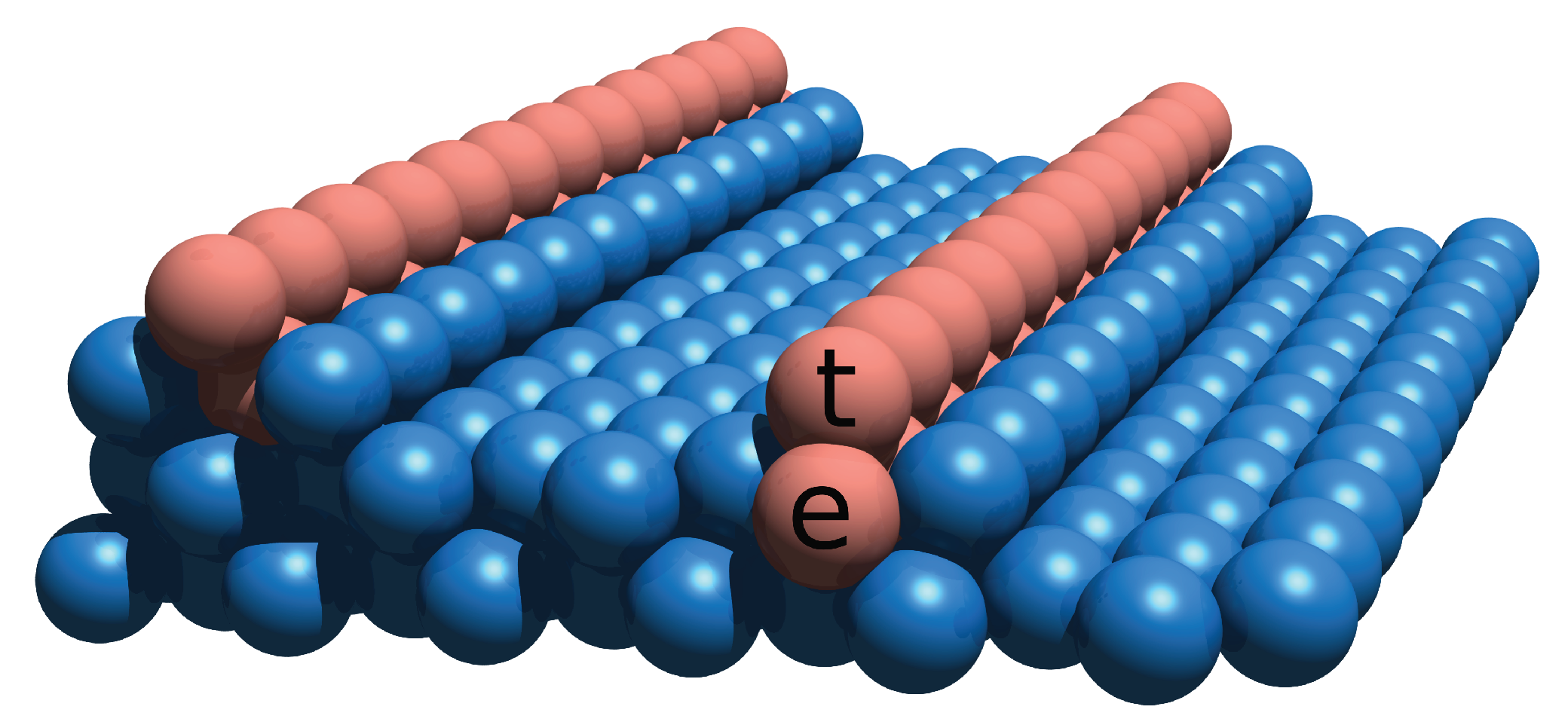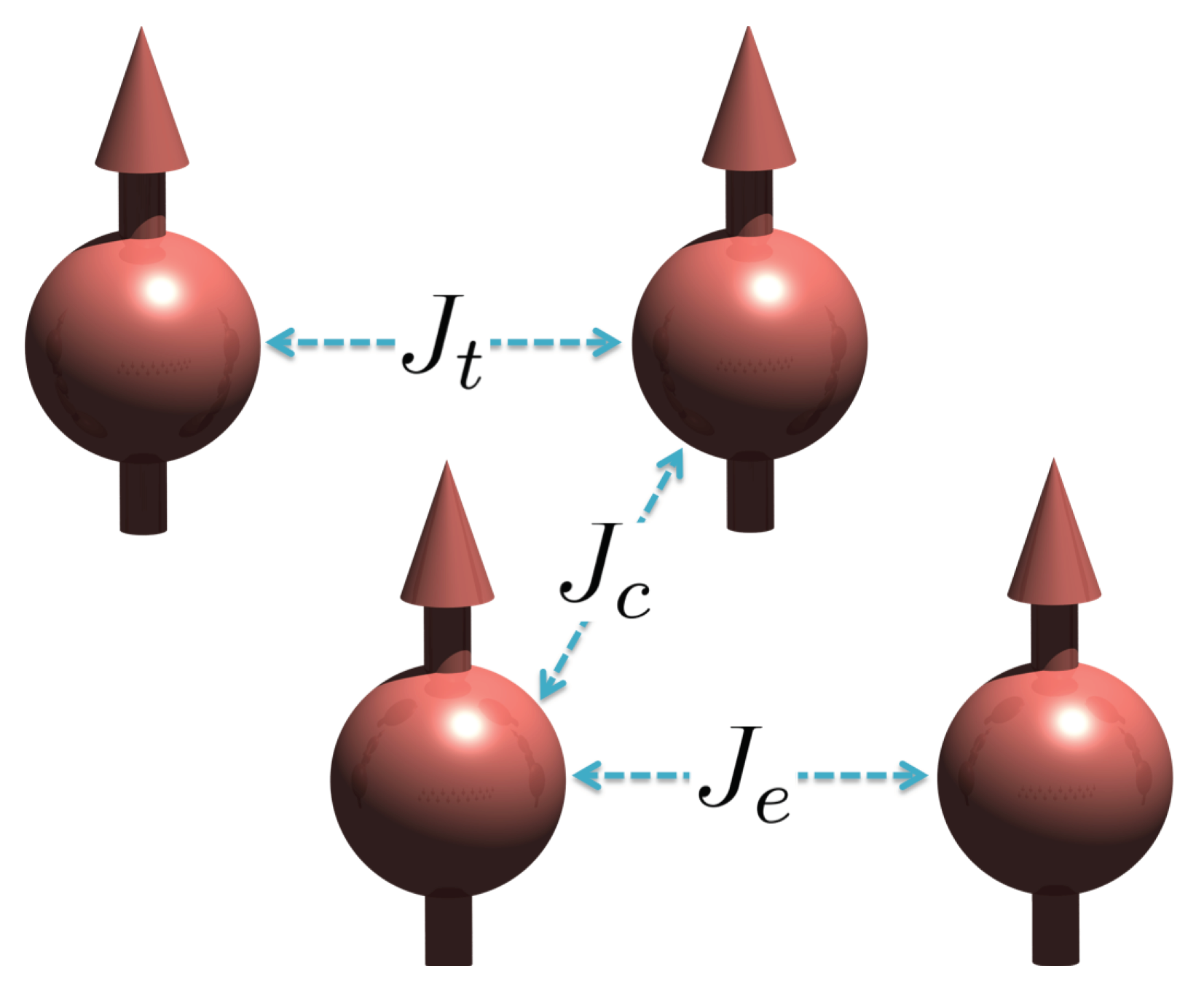Substrate-Controlled Magnetism: Fe Nanowires on Vicinal Cu Surfaces
Abstract
1. Introduction
2. Theoretical Method
3. Results and Discussion
3.1. Results from Previous Works
3.1.1. Real Structure of Embedded Fe Wires
3.1.2. Magnetic Exchange Interactions
3.1.3. : Intrawire Exchange Coupling
3.2. Results from This Work
3.2.1. : Interwire Exchange Coupling
3.2.2. Magnetism at Finite Temperatures
4. Conclusions
Author Contributions
Funding
Acknowledgments
Conflicts of Interest
References
- Shen, J.; Skomski, R.; Klaua, M.; Jenniches, H.; Manoharan, S.S.; Kirschner, J. Magnetism in one dimension: Fe on Cu(111). Phys. Rev. B 1997, 56, 2340–2343. [Google Scholar] [CrossRef]
- Shen, J.; Klaua, M.; Ohresser, P.; Jenniches, H.; Barthel, J.; Mohan, C.V.; Kirschner, J. Structural and magnetic phase transitions of Fe on stepped Cu(111). Phys. Rev. B 1997, 56, 11134–11143. [Google Scholar] [CrossRef]
- Guo, J.; Mo, Y.; Kaxiras, E.; Zhang, Z.; Weitering, H.H. Formation of monatomic Fe chains on vicinal Cu(111) surfaces: An atomistic view. Phys. Rev. B 2006, 73, 193405. [Google Scholar] [CrossRef]
- Hirjibehedin, C.F.; Lutz, C.P.; Heinrich, A.J. Spin Coupling in Engineered Atomic Structures. Science 2006, 312, 1021–1024. [Google Scholar] [CrossRef] [PubMed]
- Gambardella, P.; Dallmeyer, A.; Maiti, K.; Malagoli, M.C.; Eberhardt, W.; Kern, K.; Carbone, C. Ferromagnetism in one-dimensional monatomic metal chains. Nature 2002, 416, 301. [Google Scholar] [CrossRef]
- Lounis, S.; Dederichs, P.H.; Blügel, S. Magnetism of Nanowires Driven by Novel Even-Odd Effects. Phys. Rev. Lett. 2008, 101, 107204. [Google Scholar] [CrossRef]
- Lazarovits, B.; Szunyogh, L.; Weinberger, P.; Újfalussy, B. Magnetic properties of finite Fe chains at fcc Cu(001) and Cu(111) surfaces. Phys. Rev. B 2003, 68, 024433. [Google Scholar] [CrossRef]
- Tung, J.C.; Guo, G.Y. Systematic ab initio study of the magnetic and electronic properties of all 3d transition metal linear and zigzag nanowires. Phys. Rev. B 2007, 76, 094413. [Google Scholar] [CrossRef]
- Mokrousov, Y.; Bihlmayer, G.; Blügel, S.; Heinze, S. Magnetic order and exchange interactions in monoatomic 3d transition-metal chains. Phys. Rev. B 2007, 75, 104413. [Google Scholar] [CrossRef]
- Mo, Y.; Zhu, W.; Kaxiras, E.; Zhang, Z. Electronic Nature of Step-Edge Barriers against Adatom Descent on Transition-Metal Surfaces. Phys. Rev. Lett. 2008, 101, 216101. [Google Scholar] [CrossRef]
- Spišák, D.; Hafner, J. Fe nanowires on vicinal Cu surfaces: Ab initio study. Phy. Rev. B 2002, 65, 235405. [Google Scholar] [CrossRef]
- Spišák, D.; Hafner, J. Magnetism of ultrathin wires suspended in free space and adsorbed on vicinal surfaces. Phys. Rev. B 2003, 67, 214416. [Google Scholar] [CrossRef]
- Spišák, D.; Hafner, J. Magnetism of monoatomic wires on vicinal surfaces. Comput. Mater. Sci. 2003, 27, 138–150. [Google Scholar] [CrossRef]
- Spišák, D.; Hafner, J. Magnetism of ultrathin nanowires: ab initio study. Comput. Mater. Sci. 2004, 30, 278–282. [Google Scholar] [CrossRef]
- Mo, Y.; Varga, K.; Kaxiras, E.; Zhang, Z. Kinetic Pathway for the Formation of Fe Nanowires on Stepped Cu(111) Surfaces. Phys. Rev. Lett. 2005, 94, 155503. [Google Scholar] [CrossRef] [PubMed]
- Tegenkamp, C. Vicinal surfaces for functional nanostructures. J. Phys. Condens. Matter 2009, 21, 1013002. [Google Scholar] [CrossRef]
- Negulyaev, N.N.; Stepanyuk, V.S.; Hergert, W.; Bruno, P.; Kirschner, J. Atomic-scale self-organization of Fe nanostripes on stepped Cu(111) surfaces: Molecular dynamics and kinetic Monte Carlo simulations. Phy. Rev. B 2008, 77, 085430. [Google Scholar] [CrossRef]
- Hashemi, H.; Hergert, W.; Stepanyuk, V.S. Magnetic states of M-Fe wires (M = Sc-Ni) on vicinal Cu(111) from first principles. Phys. Rev. B 2010, 81. [Google Scholar] [CrossRef]
- Hashemi, H.; Hergert, W.; Stepanyuk, V. Magnetic properties of 3d transition metal chains on vicinal Cu(111) surface. J. Magn. Magn. Mater. 2010, 322, 1296–1299. [Google Scholar] [CrossRef]
- Kresse, G.; Hafner, J. Ab initio molecular dynamics for open-shell transition metals. Phys. Rev. B 1993, 48, 13115–13118. [Google Scholar] [CrossRef]
- Kresse, G.; Furthmüller, J. Efficient iterative schemes for ab initio total-energy calculations using a plane-wave basis set. Phys. Rev. B 1996, 54, 11169–11186. [Google Scholar] [CrossRef] [PubMed]
- Blöchl, P.E. Projector augmented-wave method. Phys. Rev. B 1994, 50, 17953–17979. [Google Scholar] [CrossRef] [PubMed]
- Perdew, J.P.; Burke, K.; Ernzerhof, M. Generalized Gradient Approximation Made Simple. Phys. Rev. Lett. 1996, 77, 3865–3868. [Google Scholar] [CrossRef] [PubMed]
- Hashemi, H.; Bregman, A.; Nabi, H.S.; Kieffer, J. Magnetic anisotropy energies of M-Fe wires (M = V-Co) on vicinal Cu(111). RSC Adv. 2016, 6, 108948–108954. [Google Scholar] [CrossRef]
- Fischer, G.; Däne, M.; Ernst, A.; Bruno, P.; Lüders, M.; Szotek, Z.; Temmerman, W.; Hergert, W. Exchange coupling in transition metal monoxides: Electronic structure calculations. Phys. Rev. B 2009, 80, 014408. [Google Scholar] [CrossRef]
- Liechtenstein, A.; Katsnelson, M.; Antropov, V.; Gubanov, V. Local spin density functional approach to the theory of exchange interactions in ferromagnetic metals and alloys. J. Magn. Magn. Mater. 1987, 67, 65–74. [Google Scholar] [CrossRef]
- Hashemi, H.; Fischer, G.; Hergert, W.; Stepanyuk, V.S. Magnetic properties of 3d transition metal wires on vicinal Cu(111) surfaces at finite temperature. J. Appl. Phys. 2010, 107. [Google Scholar] [CrossRef]
- Ignatiev, P.A.; Negulyaev, N.N.; Niebergall, L.; Hashemi, H.; Hergert, W.; Stepanyuk, V.S. Electronic structure and magnetism of monatomic one-dimensional metal nanostructures on metal surfaces. Phys. Status Solidi-B 2010, 247, 2537–2549. [Google Scholar] [CrossRef]
- Bürgi, L.; Knorr, N.; Brune, H.; Schneider, M.; Kern, K. Two-dimensional electron gas at noble-metal surfaces. Appl. Phys. A 2002, 75, 141–145. [Google Scholar] [CrossRef]
- Wahl, P.; Simon, P.; Diekhöner, L.; Stepanyuk, V.S.; Bruno, P.; Schneider, M.A.; Kern, K. Exchange Interaction between Single Magnetic Adatoms. Phys. Rev. Lett. 2007, 98, 056601. [Google Scholar] [CrossRef]
- Stepanyuk, V.; Niebergall, L.; Baranov, A.; Hergert, W.; Bruno, P. Long-range electronic interactions between adatoms on transition metal surfaces. Comput. Mater. Sci. 2006, 35, 272–274. [Google Scholar] [CrossRef][Green Version]
- Hashemi, H. First Principles Study of Magnetic Properties of Nanowires on Cu Surfaces. Ph.D. Thesis, Martin Luther University of Halle-Wittenberg, Halle, Germany, 2015. [Google Scholar]
- Khajetoorians, A.A.; Wiebe, J.; Chilian, B.; Wiesendanger, R. Realizing All-Spin–Based Logic Operations Atom by Atom. Science 2011, 332, 1062–1064. [Google Scholar] [CrossRef] [PubMed]
- Patrone, P.N.; Einstein, T.L. Anisotropic surface-state-mediated RKKY interaction between adatoms. Phys. Rev. B 2012, 85, 045429. [Google Scholar] [CrossRef]
- Simon, E.; Újfalussy, B.; Lazarovits, B.; Szilva, A.; Szunyogh, L.; Stocks, G.M. Exchange interaction between magnetic adatoms on surfaces of noble metals. Phys. Rev. B 2011, 83, 224416. [Google Scholar] [CrossRef]
- Brovko, O.O.; Stepanyuk, V.S.; Bruno, P. Effect of exchange interaction on the spin-polarized bound states on metal surfaces: Ab initio study. Phys. Rev. B 2008, 78, 165413. [Google Scholar] [CrossRef]
- Stepanyuk, V.S.; Baranov, A.N.; Tsivlin, D.V.; Hergert, W.; Bruno, P.; Knorr, N.; Schneider, M.A.; Kern, K. Quantum interference and long-range adsorbate-adsorbate interactions. Phys. Rev. B 2003, 68, 205410. [Google Scholar] [CrossRef]
- Stepanyuk, V.S.; Niebergall, L.; Longo, R.C.; Hergert, W.; Bruno, P. Magnetic nanostructures stabilized by surface-state electrons. Phys. Rev. B 2004, 70, 075414. [Google Scholar] [CrossRef]
- Lau, K.; Kohn, W. Indirect long-range oscillatory interaction between adsorbed atoms. Surf. Sci. 1978, 75, 69–85. [Google Scholar] [CrossRef]
- Ignatiev, P.A.; Stepanyuk, V.S.; Klavsyuk, A.L.; Hergert, W.; Bruno, P. Electronic confinement on stepped Cu(111) surfaces: Ab initio study. Phys. Rev. B 2007, 75, 155428. [Google Scholar] [CrossRef]
- Mermin, N.D.; Wagner, H. Absence of Ferromagnetism or Antiferromagnetism in One- or Two-Dimensional Isotropic Heisenberg Models. Phys. Rev. Lett. 1966, 17, 1133–1136. [Google Scholar] [CrossRef]





| freestanding Fe chain | |
| J | 114.54 |
| freestanding Fe wire | |
| 80.33 | |
| 150.42 | |
| 80.33 | |
| embedded Fe wire | |
| 79.76 | |
| 80.00 | |
| 74.58 | |
| Surface | (4,2,2) | (5,3,3) | (6,4,4) | (7,5,5) | (8,6,6) | (9,7,7) |
| Seperation (Å) | 6.31 | 8.45 | 10.62 | 12.81 | 15.02 | 17.23 |
| (meV) | +51.75 | −33.52 | +2.16 | −0.55 | −0.32 | −0.14 |
| Surface | (4,2,2) | (5,3,3) | (6,4,4) | (7,5,5) | (8,6,6) | (9,7,7) |
| 445 | 431 | 312 | 271 | 266 | 262 |
© 2020 by the authors. Licensee MDPI, Basel, Switzerland. This article is an open access article distributed under the terms and conditions of the Creative Commons Attribution (CC BY) license (http://creativecommons.org/licenses/by/4.0/).
Share and Cite
Hashemi, D.; Waters, M.J.; Hergert, W.; Kieffer, J.; Stepanyuk, V.S. Substrate-Controlled Magnetism: Fe Nanowires on Vicinal Cu Surfaces. Nanomaterials 2020, 10, 159. https://doi.org/10.3390/nano10010159
Hashemi D, Waters MJ, Hergert W, Kieffer J, Stepanyuk VS. Substrate-Controlled Magnetism: Fe Nanowires on Vicinal Cu Surfaces. Nanomaterials. 2020; 10(1):159. https://doi.org/10.3390/nano10010159
Chicago/Turabian StyleHashemi, D., M. J. Waters, W. Hergert, J. Kieffer, and V. S. Stepanyuk. 2020. "Substrate-Controlled Magnetism: Fe Nanowires on Vicinal Cu Surfaces" Nanomaterials 10, no. 1: 159. https://doi.org/10.3390/nano10010159
APA StyleHashemi, D., Waters, M. J., Hergert, W., Kieffer, J., & Stepanyuk, V. S. (2020). Substrate-Controlled Magnetism: Fe Nanowires on Vicinal Cu Surfaces. Nanomaterials, 10(1), 159. https://doi.org/10.3390/nano10010159




